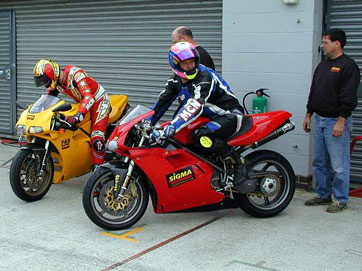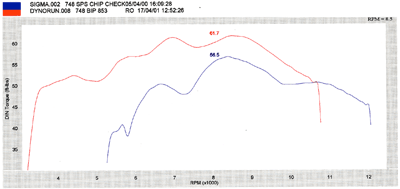|
The original Desmo Quattro was a 748, it was an experimental 4 valve racer used at the Bol d'Or in 1986 and the 4 valve heads were built onto the then top of the range 750 F1 Pantah crankcases.
Ducati had been given the budget to take on the Japanese by the company's new owners the Castiglioni's.
With help from Cosworth, Inginiere Bordi updated the 4V Desmodromic treatise he had prepared as a student at Bologna University and set to work. The valves were quite small and, to get the Desmodromic mechanism in between the valves, the valve angle was not as flat as Cosworth would have liked (an included angle of 40 degrees rather than a sub 30-degree number that could have been achieved with valve springs). Ducati wanted to stick with their preferred Desmo system and decided the sacrifice was worth it. The bore and stroke were the same numbers as the F1 engine; 88mm bore and 61.5 mm stroke.
During the road bikes development stronger crankcases were designed and the engine grew with the 851 (92 x 64 mm)
being the first engine released. The valves were unchanged from the prototype and were still designed to fit over an 88mm bore however. As the road bike range got bigger the engines grew in size, first
to 888, (with 94mm pistons) then 916cc, by taking the stroke up to 66 mm. Apart from increased valve sizes, the head remained (as they say in the song) the same.
Once the 916 range was established Ducati wanted a smaller sports bike; not as one would expect, just to compete in
another capacity category, but also to allow a different experience to the owners, this was to be an engine that thrived on revs, buzzy and radical compared to the 916's tractor like torque.
The bike comes with slightly lighter flywheels and a closer ratio gearbox (the same one found in the 996SPS actually). The market dictated that it should be sold for less than a 916, and although I have taken apart many of both models I still have not worked out why it is any cheaper to build a 748 than a 916 (or a 996 for that matter) as apart from bore and stroke they are identical. This leaves us in the superb position of having many 748's out on the street that can be best looked upon as shrunken 916's, seriously overbuilt in terms of strength.
 The 748 range has historically had several different models. The basic is the 748 Biposto, then there was the 748 SP and SPS. Since 2000 the
748R replaced the SPS (if you want more in depth info on these bikes have a look at our articles on the 748SPS here and 748R here). The same Biposto engine also comes in the 748 Mono (in the States) and the economy 748S and
748 Dark models. The engine has a wonderful free revving quality and makes superb noises both from under the tank and through the pipes because of the revs. The 748 range has historically had several different models. The basic is the 748 Biposto, then there was the 748 SP and SPS. Since 2000 the
748R replaced the SPS (if you want more in depth info on these bikes have a look at our articles on the 748SPS here and 748R here). The same Biposto engine also comes in the 748 Mono (in the States) and the economy 748S and
748 Dark models. The engine has a wonderful free revving quality and makes superb noises both from under the tank and through the pipes because of the revs.
If there is a problem it is that the redline is very near to the long term reliability limit for
the desmo system operating the valves. Most street owners do not get any problems, but by the time you have the redline of 11500 rpm being hit really regularly (you will only do this by going
flat out on a motorway or blitzing round racetrack) things will need servicing more than every 6000 miles to keep them reliable.
All of our work is designed to maximise (optimise is probably the right word) the power
producing potential of the parts that Ducati built in the first place. We try to remember that an average owner is not interested in the 200 mile valve jobs that keeping a full on racer like a 748
RS 'on track and competitive' requires.
The 748 Biposto makes our job easier; as we have pointed out above there is no internal
difference between a 748 and a 916 apart from the bits that are affected by the bore and stroke changes. In a perfect world you would want to keep the revvy, effervescent, nature most owners
wanted when they bought the bike, you would also want to give it a bit more grunt out of the corners and allow the usual speeds with a little less stress on the valve gear. If you could do this
without any compromise in reliability you would have the best bike Ducati never built.
The Best Bike Ducati Never built.
Steve Bennett bumped into us at a track day at Silverstone. He had a 748 Bip at home but was
getting a bit annoyed at how hard he had to work to keep up with his friends new 'Japanese 1000 four' toys and he wanted to do something about it, his bike was also ready for its next service.
We discussed the alternatives, a new 748R looked compelling but the trade in would be punishing
, a second hand 748SPS would be nice but the power delivery would be a bit too peaky for the road use he had in mind. Very importantly he did not want the chuggy nature of a 996 Bip; he
really wanted to keep the free revving nature of the 748.
We suggested that we could do our normal Full Monty service and while we were at it we could do
a little work on the head and fit some special 94mm pistons we had sitting around, this would bring the capacity up to 853cc. The 748 motor is very receptive to this mod as the crankcases
are the same as those used on the 916; right down to the cylinder stud spacing and the size of the holes in the cases for the cylinder spigots; indeed the OD of a cylinder on a 748 and a 916 is the same.
The 94mm pistons we use have good sealing Japanese rings (just like the latest 996R) and weigh
exactly the same as the standard 748's 88mm pistons, this means that we can go up to 853cc without any increase in reciprocating weight and therefore we don't need to lower the redline. To
keep this in perspective the standard pistons weigh 462 grams, including gudgeon (piston) pin, rings and clips. The GioCaMoto piston sold as a Ducati Performance accessory weighs over
520grams. Using these pistons would cause a major increase in vibration unless the crank was rebalanced to suit, even then using anything like the standard redline would greatly increase the
chances of a connecting rod breaking, and believe me you really wouldn't want to see what that does to your engine!
The side benefits of the increase in bore size is the unmasking of the valves (same size valves
are in the 748 as the 916), these have their flow restricted by the cylinder wall on the smaller 88mm bore engine. Our head modifications ensure the head does not interfere with low lift flow
either. The 748 combustion chamber is slightly smaller than a 916's and although we remove metal to ease the inlet valves breathing ability we end up with a slightly higher compression ratio.
Engine building is a balancing of the various effects working on the engine, more compression
equals good mid range engine acceleration, too much affects the top end power, Squish is the same, as is ignition timing. You have to build in the right amount of each ingredient but
remember not to overdo any of them. The nice thing about this engine and cam combination is the way the power hangs on once it peaks, just like the combination in a 996SPS. This is very
different to the very high peak built into a 748SPS.
We believe the compression to be around 12 to 1; up from the 11.5 to 1 claimed by the factory
for the standard engine. Obviously to get the best power we use a revised Eprom with relevant mapping to suit the greater capacity.
Once the engine is built you therefore have a 94mm bore by 61.5mm stroke engine displacing
853cc this gives an almost perfect 1.53:1 bore to stroke ratio and a similarly perfect rod to stroke ratio of 2.01:1. Compare these figures to the new 996R Testastretta engine; 1.57 to 1
bore to stroke and 1.95 to 1 rod to stroke. The engine can breathe more efficiently and the reciprocating weight is the same as the standard 748. None of the modifications are obvious
from the outside, the only clue being a slightly more basso rumble to the exhaust note.
The attached graphs tell the story (click on the image for a big version), Dyno run .004 is the
Base run 85.4 hp at 9000 rpm and a peak of 89.7 hp at 10800 rpm. R382RNL.010 is a standard 748 Biposto on which we had just completed a Full Monty service. Dyno run .008 is Steve
Bennett's 853 after it had completed a 700 mile break in. 104.1 hp at 9000 rpm but with only a 2 hp drop in the next 2000 rpm, this is really useable effective power.
The torque curves show an equally impressive increase with an increase of over 20% all the way through the range.
For a comparison with the 748SPS these charts give the facts, yes you can have the same peak power but look at the spread given by the 853, you can change gear and remain in the peak
power area. The torque curves say the same story; you can clearly see the more useable power of the 853 and the substantially higher torque of the larger engine. The 853 is going to be a very
easy bike to ride quickly with less need to use the very high revs of the SPS (although I reckon a 853SPS would be a very nice tool indeed!).
 |
Just to rub in the balance and smoothness given by the 853 have a look at these comparisons with a Post Full Monty 748R, eat your heart out 748R owners!! The final graph is a comparison
between Steve's 853 and a standard (before we get hold of it!!) 916. You can see the 853 is punching out power at the same rate as the larger engined 916 but without losing the revvy
character so beloved of most 748 owners. The smaller bikes closer ratio gearbox will also make it easier to keep right on the boil.
We can build the 748 up to 853cc as part of a Full Monty service; the only extra costs are the parts and the head modifications. You cannot tell from the outside that any changes have been
made, we quite like this bike with the 748 badges still intact; it's the original 'Q Duke'.
Neil Spalding
|